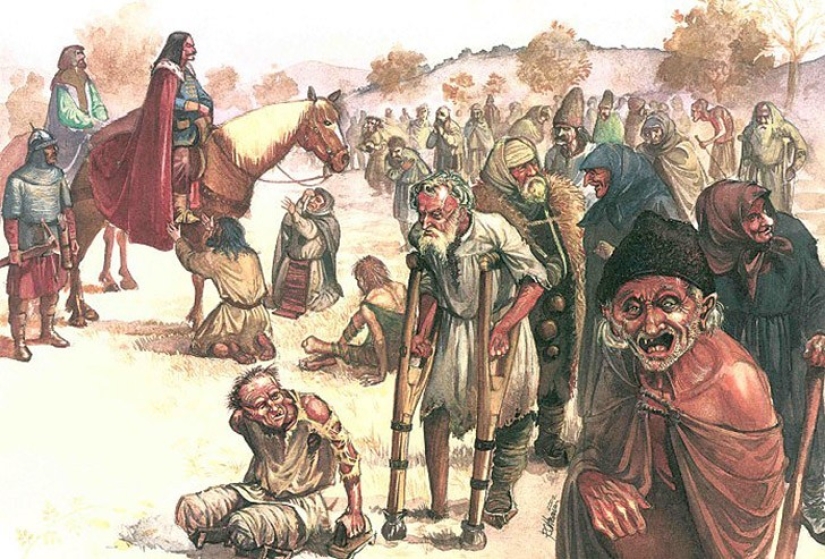9 creepy facts about the real Dracula
Categories: Celebrities | History
By Pictolic https://pictolic.com/article/9-creepy-facts-about-the-real-dracula.htmlWe all remember Count Dracula, created by Bram Stoker. He is one of the most famous vampires in literature, it was he who became the "classic" prototype of the modern vampire — an elegant and mysterious man, thirsting for human blood. However, if you didn't know, he was no match for his namesake Vlad Tepes, the ruler of Wallachia, known for his excessive "humanism" and "love" for people.

For many years he kept the whole of Wallachia in fear with his unpredictable and unbridled cruelty. Of course, he did not drink blood from the necks of the victims, but thousands of bloody executions, murders of "unworthy" residents of the city and impaling were very much to his liking, which is confirmed by the manuscripts of the 15th century. Nevertheless, there are two directly opposite points of view about him. According to the first, Tepes was a crazy sadist who took pleasure in bullying his victims. According to the second, he was a fighter against the Turks he hated. In this way, he was just trying to fight the cowardice of the soldiers and the betrayal of the boyars.

1. The prince dipped his bread into buckets with the blood of the people he had killed. A 15th-century manuscript tells how one day Dracula invited several guests to his mansion, threw a feast, and then impaled them right at the dinner table. After that, he slowly finished his lunch, dipping bread into buckets with their blood.

2. Dracula avenged his father by killing hundreds of people. And not just killed, but ripped open the bellies with blunt swords. Vlad spent most of his youth in a Turkish prison, and when he was released, he learned that his father had been betrayed by his own people, including the boyars. And since the young prince did not know the names of the traitors, he invited them all to a feast, at which they were executed.

3. Tepes preferred to be called Dracula, which means "son of the dragon". Although over time, the people assigned a different meaning to the name — "son of the Devil", which was more like the truth.

4. Dracula had a sense of humor — however, very unusual. For example, when people impaled on a stake twitched like frogs, the prince looked at them and casually remarked: "Oh, what amazing grace they have!"

5. Impaling was the only execution. It may seem that Dracula was an ordinary madman who did nothing but run around and kill people, but this is not so. Impaling was accepted as a punishment for a crime, regardless of whether the perpetrator committed murder or stole a loaf of bread. Of course, there were exceptions. One day a gypsy from a camp traveling through the lands of Dracula stole something. When he was caught, the prince ordered the unfortunate man to be boiled, and forced the other gypsies to eat him.

6. Dracula got rid of all the sick and poor by burning them alive in an attempt to restore order on the streets of the capital of Wallachia. One day he invited all the beggars, the sick and vagabonds to one of his houses under the pretext of a holiday. After they had eaten, Dracula politely apologized, went out and ordered all the windows and doors in the house to be boarded up. Then the house was burned down. According to the chronicles of that time, not a single person survived. These were still flowers: sometimes the prince burned entire villages in his possessions for no apparent reason.

7. Dracula "gave" gold cups to his subjects. The result of hundreds of murders was that Dracula was completely in control of his people and knew it. To check how much his subjects are afraid of him, he put cups of pure gold on the main square of the capital. It was announced that anyone could drink from them, but under no circumstances should the cups leave the square. At that time, about 60,000 people lived in the city, but during the entire period of the prince's reign, no one even touched these bowls, although they were in full view of thousands of people living in poverty.

8. Dracula poisoned his own wells due to the constant threat of a Turkish invasion. One day he sent troops to drive the Turks out of his land. And when the Turks began to win, Dracula began to burn his own villages so that the Turks had nowhere to rest and replenish their supplies. Moreover, he poisoned all the wells and killed thousands of residents so that the invaders would not get it all.

9. Dracula's body has disappeared.
During the war with the Turks, the prince died on the battlefield. It is believed that Dracula's body was buried in the cemetery of the Snagov Monastery on the outskirts of Bucharest. But there are contradictory rumors: some claim that the prince's body was never found, others — that the remains were buried, but then disappeared. The second version seems to be true, since Vlad III was probably buried with treasures, and robbers could get to the grave.
Recent articles

We offer you a selection of interesting facts from a variety of fields of knowledge. How does our body react to sneezing? Where did ...

Cold weather brings with it not only a wave of colds, but also skin problems. The body regularly suffers from a sharp change in ...

See what uninhibited ladies looked like at the height of the American baby boom. In those days, there was no trace of silicone, and ...